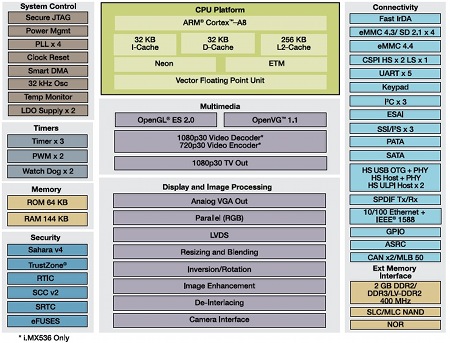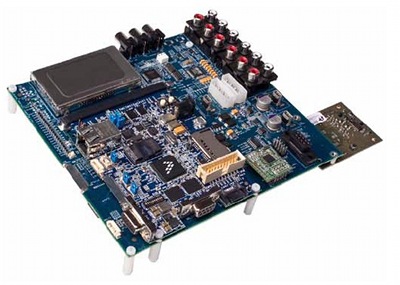Freescale’s auto SoCs offer 1080p video option
Oct 19, 2010 — by LinuxDevices Staff — from the LinuxDevices Archive — 2 viewsFreescale says it is now sampling two automotive-focused SoCs (system on chips) that employ ARM Cortex-A8 cores clocked at 800MHz. Targeting “reconfigurable instrument cluster applications,” the i.MX534 includes dual graphics processors for 2D/3D video acceleration, while the i.MX536 adds a video processor capable of 1080p decoding and 720p encoding “with minimal CPU loading,” the company says.
According to Freescale, its new i.MX534 and i.MX536, clocked at 800MHz, are auto-oriented versions of the ARM Cortex-A8 based i.MX535 it released in May. As such, they're analogous to the earlier, 600MHz i.MX514 and i.MX516 that were released last year as automotive versions of the i.MX51.
Like the i.MX514 and i.MX516, the i.MX534 and i.MX536 get wide operating ranges (from -40 to 185 deg. F) and dual graphics processing units — one for OpenGL ES 2.0 and one for OpenVG 1.1 vector graphics. And, like the i.MX535, the i.MX536 also gets hardware-based decoding of 1080p video as well as 720p encoding, according to Freescale.

A block diagram of Freescale's i.MX534 and i.MX536
(Click to enlarge)
Freecale says both the i.MX534 and i.MX536 include dual CAN controllers and an MLB50 controller, the latter compliant with the MOST (media oriented systems transport) automotive standard. Also onboard are dual camera inputs, three I2S interfaces, and an enhanced serial audio interface for multichannel synchronous audio I/O, the company says.
According to Freescale, the chips include asynchronous sample rate converter software, eliminating the need for complex software that would otherwise be needed to align multiple audio sample rates from different sources. The devices also include 10/100 Ethernet controllers with IEEE 1588 time-stamping functionality, SATA support, four USB ports, and a wide array of serial interfaces that include SDIO, SPI, I2C, and UART, the company adds.
The i.MX534 and i.MX536 are further said to be equipped with security controllers, with "high assurance boot capability," plus cipher and random number generator accelerators. Another security feature touted by Freescale is JTAG controllers that have "multiple levels of disablement."
Specifications listed for the i.MX534 and i.MX536 include:
- Application processor — 800MHz ARM Cortex-A8
- Cache — 32KB L1 instruction; 32KB L1 data; 256KB L2 cache
- Coprocessors — NEON SIMD media accelerator; vector floating point coprocessor
- Memory — external interface for up to 2GB of 400MHz DDR2, LV-DDR2 or DDR3 memory
- Video and graphics:
- OpenGL ES 2.0 and OpenVG 1.1 hardware accelerators
- multi-format 1080p video decoder and 720p video encoder hardware engine (i.MX536 only)
- single display support for up to WSXGA resolution
- dual display support for up to WVGA resolution support
- multiple display options including TFT LCD, LVDS, analog TV-formats (composite, component, RGB) and standard VGA
- hardware accelerated image post-processing, display quality enhancement, and video and graphics combining
- two simultaneous camera inputs with hardware pre-processing
- Networking — 10/100 Ethernet controller with IEEE 1588 time-stamping
- Other I/O:
- 1 x USB On-The-Go with PHY
- 1 x USB host with PHY
- 2 x additional high-Speed USB 2.0 controllers
- serial interfaces, including SDIO, SPI, I2C, UART, and I2S
- SATA
- Security:
- security controller, including secure RAM and security monitor
- high assurance boot, JTAG controller, and real-time clock
- cipher and random number generator accelerators
- unique identification for each die
- tamper detection
- Operating range — -40 to 185 deg. F (-40 to 85 deg. C)
- Package — 19 x 19mm TEPBPGA-2 (thermally enhanced ball grid array)
Software and hardware support
The i.MX534 and i.MX536 are apparently software-compatible with the i.MX535, which means they run Android, Linux, Chromium, Windows CE, as well as an optimized version of Adobe Flash Player 10.1. It seems they're pin-compatible with the i.MX535, too, since Freescale says a version of the i.MX53 EVK (evaluation kit) configured with the i.MX536 is "available today for high volume design-in activity."

Freescale's SABRE
(Click to enlarge)
According to Freescale, a SABRE (smart application blueprint for rapid engineering) platform for the i.MX534, i.MX535, and i.MX536 will become available during the first quarter of 2011 in both "automotive" and "telematics" versions. Pictured above, SABRE will employ a i.MX53 CPU card that's attached to a main board via an MXM connector, the company says.
Freescale says the SABRE CPU card will combine the SoC of choice, running at up to 800MHz, with 2GB of DDR2 RAM, 32MB of flash storage, and a NAND flash socket. It will also include LVDS and VGA video outputs, Ethernet, an SD slot, JTAG and UART interfaces, and a USB interface that's configurable either as On-The-Go, host, or slave.
The SABRE main board, meanwhile, will include features such as eight channels of audio output, a stereo line input, two microphone inputs, and an S/PDIF receiver. It will also provide connectors for video cameras, a GPS receiver, a Bluetooth module, and a 12VDC input, among other things, says Freescale.
Bernd Lienhard, vice president and general manager of Freescale's multimedia applications division, stated, "Freescale's history of leadership in the automotive industry gives us the insight to deliver solutions that meet the quality, reliability and longevity specs this market requires. Our advanced i.MX53 automotive processors enhance driver's experiences by enabling new applications and larger, more intuitive displays, which increasingly influence automotive purchasing decisions."
Further information
The i.MX534 and i.MX536 are sampling now to select customers, and will ship in volume during the first half of 2011, as will the previously announced i.MX535, Freescale says.
More information on the i.MX534 and i.MX536 may be found on the company's website here and here, respectively, while more information on SABRE may be found here [PDF link].
This article was originally published on LinuxDevices.com and has been donated to the open source community by QuinStreet Inc. Please visit LinuxToday.com for up-to-date news and articles about Linux and open source.